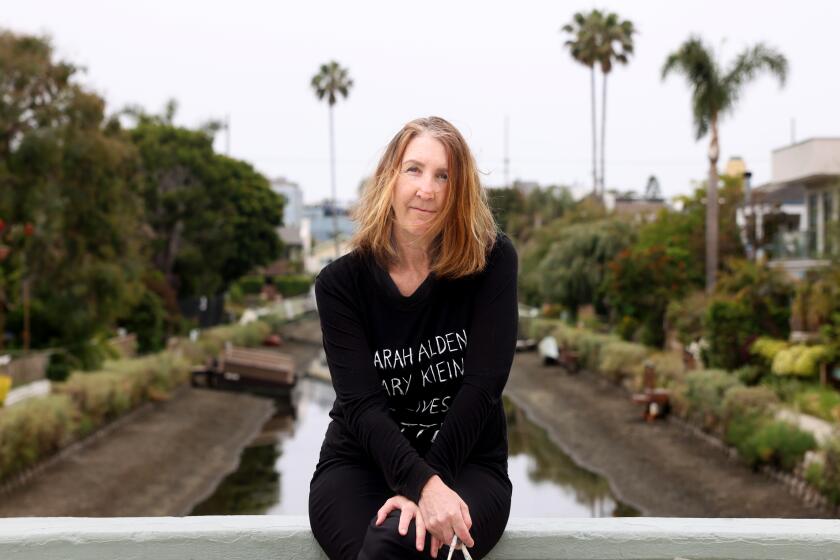MASS TRANSIT / IN THE CITY OF CARS : Ultimate Car Culture Was Built on Public Transport
Every now and then--like now--Los Angeles is reminded that there is no such thing as a functioning city without mass transit. With near-pornographic glee, the Adam Smith boys have been of late trashing the very idea of publicly supported mass transit as not only unnecessary, but an economic catastrophe. The automobile and para-transit, claim these hyper-free marketeers, left to their own devices, can out-perform public transit, no contest.
Tell that to the half-million and more commuters left stranded Monday morning by the Metropolitan Transportation Authority walk-out. In their panic about getting to work, commuters left high and dry by public transit did not have the luxury of the Adam Smith crowd’s comparative statistics. Instead, standing in bewilderment on corners where no buses came, they confronted the Gordian knot of Los Angeles transit history--from which there is no escape.
They were discovering, among other things, that the vaunted automobile culture of greater Los Angeles is dependent on public transit. Put another half-million people on the road--as the MTA strike did--and the already overloaded freeway system edges toward gridlock.
Less directly (but the lesson will sink in over time), stranded commuters were discovering that public transit, having made Los Angeles possible in the past, is irrevocably part of the Los Angeles present and future. Public transit cannot be banished. It is, among other things, public space, hence shared identity, as well as a primary agent of social justice. Public transit is a civic covenant as irrevocable as our park and library systems, our police and fire protection.
The big delusion of Los Angeles history is that public transit was banished in the 1930s and 1940s--with the scrapping of streetcars and interurban electrics. Like most delusions, this one contains a grain of historical truth. Certainly, by the late 1930s, the citizens of Los Angeles were enjoying drive-in restaurants (serviced by a new example of the American Girl--the car-hop); automobile-friendly motels and bungalow courts, and even a few drive-in churches and banks. Shops and department stores, churches and synagogues, high schools and junior colleges sustained large rear surface parking lots; and the model pioneered by the Richfield Building in the 1920s, the underground garage in an office building, was becoming increasingly common in new construction.
For geographical reasons--the barrier formed by the San Gabriel and Santa Monica Mountains on the east and the Pacific Ocean on the west--the City of Los Angeles was forced to accommodate the entire north-south traffic of Southern California, including the distribution of automobiles to the 43 cities and towns then in Los Angeles County. Not surprisingly, the City of Angels pioneered the one-way street, the traffic island and the rigid restriction of left turns into on-coming traffic.
Even more: the sound of traffic became the music of the city, like a Max Steiner score in a Hollywood film. In late 1937, a group of musicologists measured the wave frequency of traffic noises in various pitches throughout the city and discovered that the total pitch of Los Angeles was F natural, the fourth interval of the diatonic scale.
Yet back behind this identity--indeed inherent in it--was the historical creation of Los Angeles by the Big Red Cars of the Pacific Electric Co. and the yellow cars of the Los Angeles system. Perfected in the late 1880s by Frank J. Sprague, an assistant of Thomas Edison, the electric streetcar, followed by the interurban electric, made the suburb possible.
Nowhere was this more true than in Los Angeles. By 1910, the Pacific Electric linked more than 50 communities in four counties--Los Angeles, portation Orange, Riverside and San Bernardino--into one suburban whole. The system pushed as far south as Newport, as far east as Redlands, San Bernardino and Riverside, and as far north as San Fernando. There were 1,164 miles of track, the largest such electrical transit system in the world. Six hundred trains a day passed through the Los Angeles Terminal alone, the largest building west of the Mississippi.
A past like this is never shaken. The very idea of Los Angeles was invented by public transit. The automobile subsumed this identity, and, as we are now experiencing with the MTA strike, remained dependent upon its success.
Historian Scott Bottles has disproved the myth, once and for all, that a conspiracy by General Motors and other automobile and tire interests destroyed the Red Car system. It is more correct to say the system lost out to the automobile. What the detective says in the film “Who Framed Roger Rabbit?”--namely, that Los Angeles has the best streetcar system in the world and will never abandon it--has an unintended irony. Haunted by the memory of the Big Red Cars, which brought it into being, Los Angeles County is spending billions and billions of dollars on subway, light rail and bus systems--as if to re-possess the urban vitality of that mass-transit era.
The Big Red Cars, it must be remembered, were privately owned and operated. Which is the point. The key issue in the current MTA strike is the contracting of maintenance service to the private sector. This is inevitable. Sadly, the mechanics union, instead of seeking to maintain its status in the process--demanding union benefits for mechanics employed by private sub-contractors--decided to bring the entire MTA system to a halt, with disastrous results for both commuters and the cause of true unionism in the United States.
A glorious opportunity, rich in historical resonance, is being lost. What if the MTA, while remaining a public agency, reconnected with the private sector, as it is seeking to do in the issue of maintenance? What if the MTA, secure in the knowledge that it is an inevitable component of the city’s destiny, were to allow privately sponsored para-transit to supplement its services? What if the Adam Smith gang stopped trashing publicly supported mass transit and, rather, praised it for what it truly is: one of the region’s founding components. Privately owned, it must be remembered, the Big Red Cars were publicly subsidized with easements, rights of way, tax incentives and a cooperative city that cleared the way for its downtown terminal.
In transit terms, let us recover our history. Let us affirm a mix of mass transit, publicly owned and privately subcontracted; para-transit, privately owned and publicly regulated, to include expanded shuttle routes, jitney service and the encouragement of Los Angeles’ surprisingly first-rate taxicab system. And, of course, the automobile--still the region’s continuing obsession and icon, with all its gifts of privacy and choice, despite the fact that it can never fully serve the population’s transit needs.*
More to Read
Sign up for Essential California
The most important California stories and recommendations in your inbox every morning.
You may occasionally receive promotional content from the Los Angeles Times.










